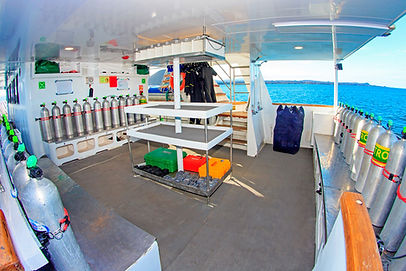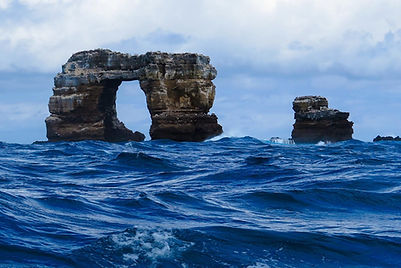
¡Explora las Islas Galápagos ahora!

DIVE SITES

Noreste de Baltra
North Seymour offers so much to see that you may wish to extend for more than one dive. The gradual rocky slope that extends from the northeast coast of Seymour Island provides a habitat for Scots donkeys, blue striped snapper and salamis. Additionally, you can also spot groups of eagle rays, spotted rays, stinger rays, horse-mackerels and hopefully, marlins. Remember to aim your camera upwards from time to time. Blue-footed boobies are frequently spotted diving and swimming down to catch their food here because of the abundance of fish.
Isla Wolf
Wolf is a small uninhabited island and one of the most emblematic diving spots in the Galápagos. The island is inhabited by birds flying on high cliffs and sea lions playing amongst rocks worn by waves. However, it is beneath the treacherous coast where the true treasures of Wolf Island unravel. Here is one of the few places where you will have the opportunity to swim alongside the huge whale sharks. Additionally, you will find groups of hammerheads, Galápagos sharks, silky, eagle rays, mantas, bluefin tuna, turtles and thousands of reef fish. The excitement to hear the harmonious whistles of dolphins will also be fulfilled.
Punta Bartolomé – Bartholomé
Punta Bartolomé is on any list of the top diving sites in the Galápagos because it is home to some of the best marine species in the region combined with incredible rock formations. Schools of fish are commonly seen in this area. These attract Galápagos penguins (the only species of penguin that can be found north of the equator), sea lions, pelagic fish, white-tipped reef sharks and a variety of rays. If you are not in the middle of a shoal, you may also see sea turtles, a variety of reef fish, manta rays and curious hammerhead sharks towards the deep.
Isla Darwin
At the far end of the archipelago, Darwin Island and its famous dive site, Darwin’s Arch, are a highlight of any diving expedition in the Galápagos. Manta rays, sea turtles, dolphins, eagle rays and other whale sharks surprise divers with their presence. The real spectacle is the large number of sharks that are attracted to the strong currents. You will likely see groups of hammerheads, silky sharks, blacktip sharks and Galápagos sharks. All at an average depth of only 9 metres.
Roca Cousins
The solitary and symmetrical pyramid of Roca Cousins rises just above the coastal waters of Santiago, approximately 5 km north of the Bartolomé islet. The diving depths of Roca Cousins range between 12-30 m, and the current can vary from medium to strong. Water temperatures range from 20-26°C from January to May, and 16-20°C from June to December. Visibility is 12 to 30 m, and the site is mostly a reef dive. Low visibility usually means an abundance of plankton thus, bringing a large number of small and pelagic fish alongside large animals.
Punta Vicente Roca
Right at the mouth of the seahorse, resembling the Isabela Island, is the Vicente Roca tip. The roaring echoes of the waves will accompany you as you enter a dark cave under a spectacular arch. Just around the corner, the collapsed amphitheater of Ecuador Volcano offers another breathtaking view. The quieter waters of the caves are well protected from the ocean’s waves and are a great place to dive among various species of sharks, penguins, puffins and even seahorses. Encounters with moonfish are also very common. It is worth noting that the water in this area is usually a little cold.
Cabo Duglas
The dive site of Cape Douglas is located in the northwest of Fernandina Island. It has an active shield volcano, La Cumbre, which has had eruptions in the last ten years. It is a nesting site for the cormorants of the Galápagos. These incredible birds evolved to live on this barren island by learning to swim and hunt underwater, rather than fly, due to the lack of terrestrial predators. Sea iguanas have also evolved to survive on these islands, making them totally unique to the region. The island is additionally home to a large number of sea lions, turtles, pelicans and Galápagos penguins.
Cabo Marshall
Cape Marshall, named the “City of Mantas,”, is located on the northeast coast of Isabela Island, a little south of the equator and on the base of the Wolf volcano. This area offers drift diving and a nearly vertical wall of volcanic rock that falls to the bottom of the sea.
This is a great place to see hammerhead, white-tip reef and Galápagos sharks. Occasionally, you can see whale sharks. There are huge schools of saltpetre and large barracuda fish. Black coral growing along the volcanic wall are also findable.
Cape Marshall´s main attraction is the high likelihood to see giant mantas. They are attracted to plankton-rich waters for feeding so there might be low visibility.

By Poseidon Expeditions!
DIVING CONDITIONS

Current
Strong currents present as one of the most challenging aspects of diving in the Galápagos. At times, you may encounter currents that are too strong to swim against (2-4 knots). In general, moderate to strong currents are expected. In most dive sites the strength of currents fluctuates often, sometimes even halfway through the dive.
Diving at sea
The majority of dives in the Galápagos are regarded as drift dives since currents flow along the islands and divers typically follow the current's path.
Tidal waves
Whenever there are currents or tidal waves, you will see that it gets stronger in shallow areas. At the end of your dive, ascend to the surface and swim towards the deep end, away from the Islands rocks. This assists the boat to easily reach you easily and safely without worrying about being pushed into the rocks by the waves.
Most dive profiles are in the range of 6-24 meters. However, most sites have depths that easily reach or exceed 40 m. The greatest variety of life and activity is typically found between the surface and 18 m, so you don’t need to dive deep in the Galápagos. This general rule only changes during the El Niño years, when hammerhead and other sharks stay deeper, following their food sources and avoiding warmer waters at lower depths.
Depth
Visibility
The range of visibility in the Galápagos is typically between 10 and 21 meters, though it can reach up to 30 meters.
Water temperature
Surface water temperature varies from 18 to 25 degrees C (64 to 77 degrees F). In contrast, temperatures at greater depth can drop to 13°C (56°F) and thermoclines (which generally occur between depths of 12-18 m (40-60 ft) can cause a sudden temperature drop of up to 69°C. You will often feel these changes in water temperature as you go through the outcrop of deep ocean currents during a dive.
Diving suits
Layering is the best plan for diving in the Galápagos. A 7 mm wetsuit with hood, boots and lightweight gloves is a good choice; or a 5 mm full-hood dry suit will keep most divers very warm.






MORE DETAILS AFTER BOOKING!


